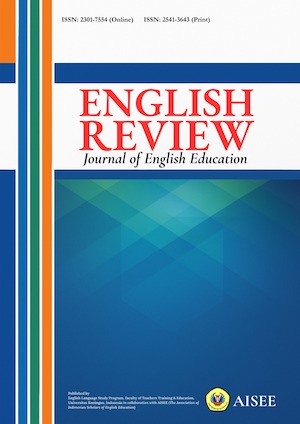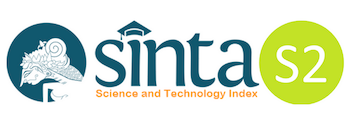TEACHING ENGLISH USING ICE BREAKING TO TAIWANESE STUDENTS: EFL TEACHER’S EXPERIENCES
Abstract
This research examined the challenge, strategy, advantages, and disadvantage of using icebreakers when learning English among Taiwanese students. This research used narrative inquiry as its research design. Data collection was done through interviews conducted with an EFL teacher who was completing a doctoral program in Taiwan. Data analysis included identifying key themes from interview data. The research results stated that the use of ice breaking has challenges, strategies, advantages, and disadvantages when learning in class. The challenge was that students felt bored when the teacher used the same type of icebreaker over and over again. The strategy was to use technology-based icebreakers. The advantage was that it could improve a conducive learning environment. The disadvantage was that teachers had to have various types of icebreakers. This research underlines the complexities of employing icebreakers in English language instruction, as well as the significance of continued efforts, teacher flexibility, and creative variation to accommodate students' particular needs. In conclusion, a balanced and thoughtful approach to using icebreakers is critical to fostering a successful enjoyable classroom for Taiwanese studentsReferences
Adi, M. S., Susanti, R. A., & Jannah, Q. (2021). The Effectiveness of ice breaking to increase students’ motivation in learning English. International Journal of English Education and Linguistics (IJoEEL), 3(1), 31–38. https://doi.org/10.33650/ijoeel.v3i1.2256
Adila, J., Nazari, A., Abdollahi-Guilani, M., & Sengkey, V. G. (2018). Motivation and attitude towards learning English: A case study of Rasht Islamic Azad University. Modern Journal of Language Teaching Methods, 17(9), 1689–1699. http://search.proquest.com/central/docview/1779892460/99943899EC314221PQ/1?accountid=62831
Agusriana, C. F. (2021). Teachers’ perception on the use of ice breaking strategy in teaching and learning process.
Al Ghifarah, N., & Pusparini, R. (2023). Students’ perception towards the role of ice breaking activities in learning English at senior high school. Journal of English Language Teaching and Literature (JELTL), 6(2), 118–128. https://doi.org/10.47080/jeltl.v6i2.2793
Astuti R, Asti S, & Intan S. (2020). The influence of ice breaker to students’ motivation in teaching English. PROJECT (Professional Journal of English Education), 3(2), 210–216. doi:10.22460/project.v3i2.p210-216
Cirocki, A., & Farrell, T. S. C. (2019). Professional development of secondary school EFL teachers: Voices from Indonesia. System, 85, 102111. https://doi.org/10.1016/j.system.2019.102111
Clandinin, D. J. (2016). Engaging in narrative inquiry. Engaging in Narrative Inquiry, 1–232. https://doi.org/10.4324/9781315429618
Darmayanti, R., Arif, V. R., Soebagyo, R. I., Ali, M., & In’am, A. (2023). How can ice-breaking’s “friends here, enemies there” increase the interest and enthusiasm of high school students for learning? AMCA Journal of Science and Technology, 3(2), 53–60. https://doi.org/10.51773/ajst.v3i2.244
Escobar Fandiño, F. G., Muñoz, L. D., & Silva Velandia, A. J. (2019). Motivation and e-learning English as a foreign language: A qualitative study. Heliyon, 5(9). https://doi.org/10.1016/j.heliyon.2019.e02394
Farwati, D. Z., Rahmah, M., & Sutisna, E. (2019). The application of ice breaking activities in teaching. Journal of English Teaching and Linguistics Studies (JET Li), 1(1). https://doi.org/ 10.55215/jetli.v1i1.1489
Fitria, T. N. (2023). Breaking the ice in the classroom: Using ice-breaking in the teaching and learning process. Borneo Journal of English Language Education, 5(1), 23–38.
Giani, W. A., Safiya, D. A. S., & Damanik, B. R. A. (2022). Use of ice-breaking methods in increasing student concentration amid online learning during COVID-19 pandemic. ASEAN Journal of Community Science and Education, 1(1), 43–50. https://ejournal.bumipublikasinusantara.id/index.php/ajcse/article/view/70
Hamrin, J. (2022). Icebreakers - an effective teaching strategy or a waste of time?. (Thesis). Dalarna University.
Haydon, G., Browne, G., & van der Riet, P. (2018). Narrative inquiry as a research methodology exploring person centred care in nursing. Collegian, 25(1), 125–129. https://doi.org/10.1016/j.colegn.2017.03.001
Husna, A. H., & Murtini, R. T. (2019). A study on students’ motivation in learning English as English foreign language (EFL) at stikes cendekia utama kudus. Journal of English Teaching and Research, 4(2), 207–220. https://ojs.unpkediri.ac.id/index.php/inggris/article/download/13745/1377/
Kamel, A. M., Omar, A., & Awad, A. (2019). The effectiveness of ice-breaker strategy in enhancing motivation and producing conducive classroom atmosphere for the tenth graders in English classes in Nablus city schools from the perspectives of teachers and students. https://hdl.handle.net/20.500.11888/17365
Mahmud, A. F., Yusup, A., & Saban, A. H. (2023). The implementation of ice-breaking activities in English classroom: A descriptive study of the second-grade students’ perceptions at SMA Al-Irsyad Kota Ternate. Langua: Journal of Linguistics, Literature, and Language Education, 6(1), 108–117.
Morris, L. S., Grehl, M. M., Rutter, S. B., Mehta, M., & Westwater, M. L. (2022). On what motivates us: A detailed review of intrinsic v. extrinsic motivation. Psychological Medicine, 52(10), 1801–1816. https://doi.org/10.1017/S0033291722001611
Namaziandost, E., & Nasri, M. (2019). The impact of social media on EFL learners’ speaking skill: A survey study involving EFL teachers and students. Journal of Applied Linguistics and Language Research, 6(3), 199–215. www.jallr.com
Parupalli Srinivas. (2019). The importance of speaking skills in English classrooms. Alford Council of International English & Literature Journal(ACIELJ), 2(2), 9.
Pratama, H., Maduretno, T. W., & Yusro, A. C. (2021). Online learning solution: Ice breaking application to increase student motivation. Journal of Educational Science and Technology, 7(1), 117–125. https://doi.org/10.26858/est.v7i1.19289
Puspitarini, Y. D., & Hanif, M. (2019). Using learning media to increase learning motivation in Elementary School. Anatolian Journal of Education, 4(2), 53–60. https://doi.org/10.29333/aje.2019.426a
Rahmayanti, P., Saraswati, P. A., & Bhuana, G. P. (2019). The use of ice breaker to improve students’ motivation in learning English at the tenth grade students of Smk Ypkkp. PROJECT (Professional Journal of English Education), 2(5), 594. https://doi.org/10.22460/project.v2i5.p594-600
Rusman, K. B. (2022). Implementation and benefits of learning through ice breaking. International Linguistics and TESOL Journal, 1(1), 3.
Sabry Daif-Allah, A., & Aljumah, F. H. (2020). Differences in motivation to learning English among Saudi University students. English Language Teaching, 13(2), 63. https://doi.org/10.5539/elt.v13n2p63
Sari, M. N., & Ningsih, P. E. A. (2022). An analysis of students’ motivation and anxiety on learning English at SMA Negeri 6 Kerinci. Pendekar: Jurnal Pendidikan Berkarakter, 5(3), 181. https://doi.org/10.31764/pendekar.v5i3.10994
Sari, U. A., Fauziyah, N., Ghozi, A., Azizah, I. N., & Al-Fidyah, U. F. (2021). Improving the students’ learning concentration through ice breaking. Proceedings of the International Conference on Engineering, Technology and Social Science (ICONETOS 2020), 529(Iconetos 2020), 614–619. https://doi.org/10.2991/assehr.k.210421.089
Sasan, J. M. V, Tugbong, G. M., & Alistre, K. L. C. (2023). An exploration of icebreakers and their impact on student engagement in the classroom. International Journal of Social Service and Research, 3(11), 2921–2930. https://doi.org/10.46799/ijssr.v3i11.566
Triyono, Kasih, F., Adison, J., & Febriani, R. D. (2023). Ice breking to boost learning motivation in students. Human: Journal of Community and Public Service, 2(2), 57–62. https://doi.org/https://journal.haqipub.com/index.php/human/article/view/321
Wang, J. (2023). Design and implementation of English teaching analysis system based on mobile terminal. Procedia Computer Science, 228, 300–306. https://doi.org/10.1016/j.procs.2023.11.034
All articles published in English Review: Journal of English Education (ERJEE) are licensed under the Creative Commons Attribution 4.0 International License (CC BY 4.0).
Copyright Ownership
Authors retain the copyright of their articles and grant ERJEE the right of first publication. The journal is granted a non-exclusive license to publish, reproduce, and distribute the article in any format, medium, or platform, provided that proper credit is given to the original authors.
License Terms – CC BY 4.0
Under the Creative Commons Attribution 4.0 International License, others are free to:
- Share — copy and redistribute the material in any medium or format
- Adapt — remix, transform, and build upon the material for any purpose, even commercially
As long as they:
- Provide appropriate credit to the original author(s) and source
- Provide a link to the license (https://creativecommons.org/licenses/by/4.0/)
- Indicate if any changes were made
There are no restrictions on the reuse, reproduction, or adaptation of published articles as long as attribution is properly given.
Author Warranties
By submitting a manuscript to ERJEE, authors confirm that:
- The work is original and does not infringe any existing copyright.
- The manuscript has not been previously published and is not under consideration elsewhere.
- All sources and references are appropriately acknowledged.
- Necessary permissions have been obtained for any copyrighted materials used.









